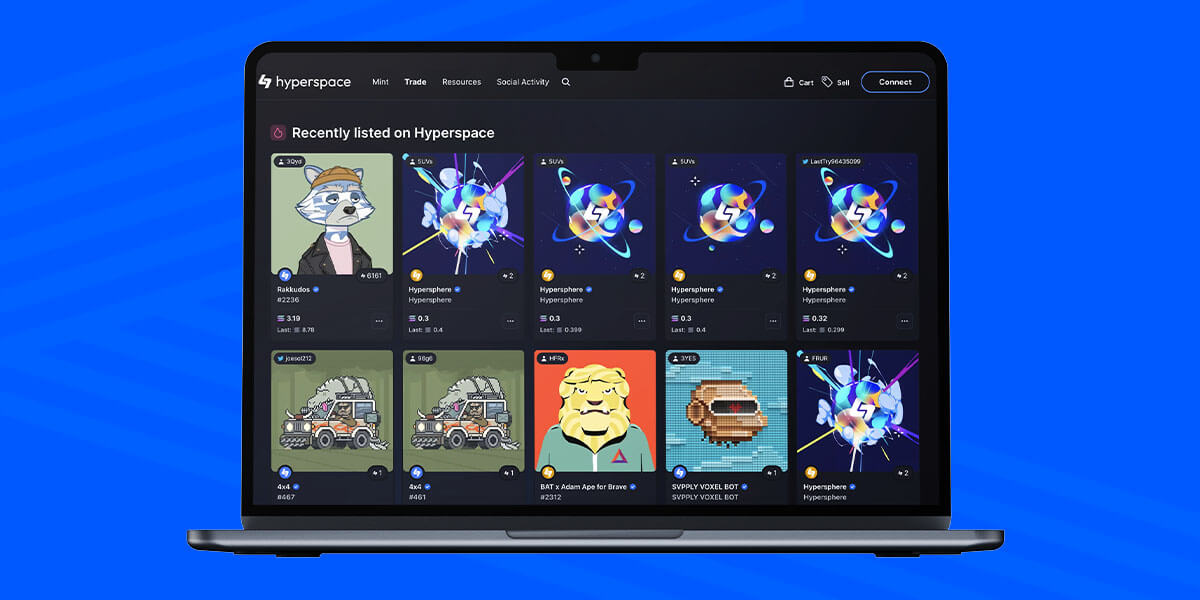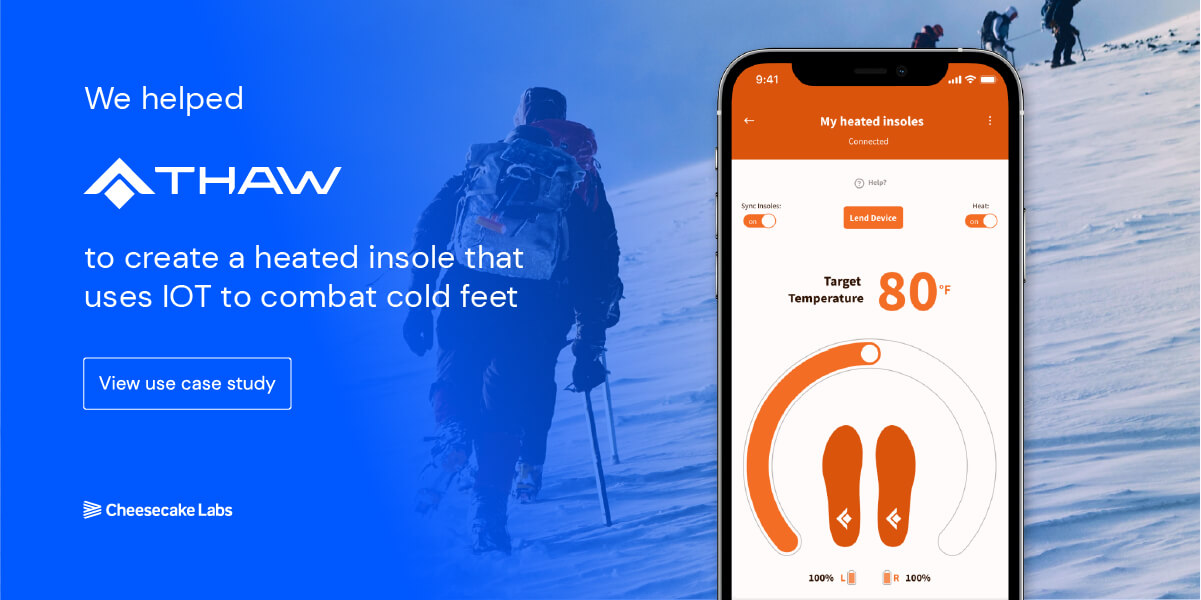What Are Stablecoins, and Why Should You Know About Them?
Gabriel Soares | Nov 26, 2025

Have you encountered the terms digital immunity, internet balkanization, or super apps yet? Do you know how these technology trends in 2023 can guide your growth, enhance your projects, and affect how customers reach your business?
Let’s look at what we think are some of the top trends in tech that may open opportunities for new business models, markets, and products.
When it comes to blockchain, there are three growth areas to watch in 2023: NFT gaming, yield farming, and asset tokenization.
The desire to acquire rare items, collect limited trinkets, and obtain unique art and souvenirs is an obvious appeal for the 3 billion gamers worldwide. In the context of this unstoppable growth, industry analysts expect the following NFT gaming trends in 2023:
Cheesecake Labs recently helped Hyperspace, Solana’s largest NFT marketplace, create some new features to enhance their platform.
We provided a dedicated team of engineers who created a seamless browsing experience letting users buy any Solana NFT with zero fees, saving time and money.

This partnership allowed Hyperspace to stay ahead of the curve in the rapidly evolving NFT space and further cemented Cheesecake Labs’ expertise in delivering innovative blockchain technology solutions.
Yield farming is another blockchain technology trend to watch this year. It allows users to generate passive income by depositing their cryptocurrency into a common pool with other users. The pooled funds are then used to carry out smart contracts (like crypto lending) that generate earnings.
Rounding up the blockchain trends of 2023 is asset tokenization. This involves creating digital versions (tokens) of physical and traditional financial assets on a blockchain, which can then be purchased, sold, and traded like securities. It’s a more secure and efficient investment option for people unable to (or choose not to) hold physical assets.
Despite the gloomy crypto bear market of 2022, analytics firm CoinMetrics remains upbeat about the tokenization of real-world assets, expecting it to be a major growth area in 2023.
According to its report, banks have been experimenting with tokenized assets to accelerate transaction settlement times. And major financial institutions such as JPMorgan, Deutsche Bank, and SBI are now trading tokens based on Ethereum’s Layer 2 scaling network Polygon — indicating their increasing adoption and reliance on tokenization technologies.
Decentralized finance pioneer MakerDAO is also delving deeper into real-world assets and recently allocated $400 million for short-term treasuries and $100 million for investment-grade corporate bonds.
It’s been one year since we partnered with Stellar and have been diving deep into developing this amazing technology. Stellar’s decentralized network is a game-changer for asset issuers and holders. It offers powerful default features that enable full control over the entire asset lifecycle.
With Stellar, you can easily track, hold, and transfer any value tokens — from crypto to fiat currencies, gold, or other assets. And the future of the Stellar Network seems very promising, you can expect a boom in the Anchors, the rise of CBDCs and stablecoins, and much more.

Recently, Stellar announced the launch of the Stellar Asset Sandbox. This tool was developed in partnership with Cheesecake Labs to aid in the issuance and management of assets in the Stellar testnet.
One great example of this innovation is MBRL, the first stablecoin from Brazil created in collaboration with Mercado Bitcoin on the Stellar Network.
Learn more about how you can use the new asset issuer’s toolkit for exploring tokenization:
In a Gartner survey about overcoming obstacles to digital implementation, nearly half of the respondents (48%) reported enhancing customer experience (CX) is the primary goal of their digital investments. And to ensure that defects, system failures, bugs, or security issues don’t impact CX, many companies have started putting Digital Immune Systems (DIS) in place.
Their efforts should pay off. Businesses that invest in digital immunity are expected to see a remarkable 80% reduction in downtime by 2025 and experience greater customer satisfaction as a result.
DIS employs a combination of techniques, including software engineering, design, development, technologies, and data analytics, to automatically handle and respond to security and operational risks in real time. It safeguards applications and services, making them more resilient and allowing them to recover rapidly from failures. This reduces the likelihood of disruptions to business operations.
Privacy will also be a greater concern for individuals, governments, and businesses. The privacy landscape in 2023 will be greatly impacted by new technological trends and the geopolitical and economic events of 2022. Here are some of the major developments to expect in this area, according to Kaspersky:
The trend of internet balkanization is creating a more diverse and localized behavior-tracking market, as well as stricter controls on cross-border data transfer.
Why is this happening? We all know that websites are filled with hidden trackers that collect behavioral data for targeted advertising — and that the giants behind this industry (Meta, Amazon, and Google) are all based in the US.
The problem? Due to legal framework differences, many regions have become increasingly cautious about sharing data with foreign companies.
For instance, in July 2022, EU authorities issued multiple rulings indicating that using Google Analytics may violate the GDPR. In addition, law enforcement’s use of commercial data makes governments suspicious of foreign data-driven companies.
The result? More and more countries are implementing strict data localization laws — a trend that will likely result in a more diverse and fragmented data market and spur the rise of local web/mobile app tracking companies.
France, Russia, and South Korea already have well-established web tracking systems with dominant players, and more nations may adopt a similar approach, exhibiting a preference for local companies.
All this could have various implications for privacy. While large tech companies may have more resources for security, they also have a history of data breaches. Smaller companies may be less likely targets for hackers, but they also receive less oversight from regulatory bodies.
The use of smartphones and other smart devices for making payments through NFC or QR code methods (like Apple Pay and Samsung Pay) is increasing rapidly. And it’s likely to make traditional debit and credit cards obsolete, particularly in areas where cashless payments are already prevalent.
Interestingly, some US states are already using (or plan to use) digital IDs and driver’s licenses stored in Apple Wallet. This increasing reliance on smartphones to store personal data can make certain processes more efficient — like verifying the identity of someone applying for a loan online.
However, it also creates a single point of failure, raising security concerns and placing demands on the security of mobile devices and privacy-protecting methods for storing data.
Businesses are working harder to minimize the risks posed by human error in cybersecurity by addressing issues like insider threats and social engineering.
Human error remains the biggest security risk, even as companies employ more advanced cybersecurity strategies like endpoint protection, XDR, and proactive threat hunting.
Studies show that 91% of cyberattacks still begin with a phishing email and that phishing is involved in 32% of successful data breaches.
The tactics used by cybercriminals are growing more sophisticated, too. The FBI recently warned that job applicants could use deep fakes to deceive employers and gain access to internal IT systems.
Investing in data leak prevention solutions and improving cybersecurity awareness within organizations to counter these risks is important.
Expect to see advancements in IoT for healthcare and for IoT to start teaming up with AI to become even more powerful and useful.
The market value of IoT in healthcare devices is projected to reach $94 billion by 2026. The pandemic underscored the role of technology in healthcare, and this trend is expected to continue with IoT taking center stage.
Among the most notable developments is the use of wearable devices and in-home sensors that allow physicians and healthcare providers to monitor patients even after they are discharged.
The result? Faster access to care in case of emergencies, plus fewer hospital visits. Medical professionals can also use these technologies to enhance the effectiveness of telemedicine going forward.
“Combining IoT and healthcare creates infinite possibilities for a better life, including: remote patient monitoring, telemedicine, improved clinical decision making, and better medication management. These are just a few examples of how IoT is making a positive impact on the healthcare industry — providing connected experiences that enhance patient care, improve outcomes, and increase operational efficiency.”
Natam Oliveira, VP of Engineering, Cheesecake Labs
Expect to see AI and IoT become a powerful pair this year. AI technology can use IoT infrastructure to improve efficiency, human-to-machine communication, and data collection and analysis. Merging these two technologies (AIoT) can significantly enhance digital experiences.
IoT project spotlight: THAW
The THAW app, developed by Cheesecake Labs for ACG Brands, is a trailblazer in the world of IoT technology. THAW delivers personalized temperature control for people who love the great outdoors and want to extend their time in nature without having to worry about cold hands or toes.

The app gives customers control over the specific heat of their hand warmers and insoles, along with in-app battery life updates and synced weather reports.
Cheesecake Labs used Flutter to ensure seamless communication between the app and its devices, allowing users to set their ideal temperature for each device down to a degree. The THAW app is also designed to be shareable with friends and can work offline, making it a reliable and useful tool for outdoor activities.
A new type of application is gaining traction. It’s called the super-app, and it has the potential to completely revolutionize online marketplaces and fintech ecosystems.
A super-app is a convenient, all-inclusive app that offers users an entire ecosystem of services for their everyday needs — including cashless payments, insurance, rewards, hotel bookings, grocery ordering, and many more. These apps can also provide access to messaging services, media content, and other related functions.

WeChat is a great example of a super-app. With 1.24 billion users in China, it offers social networking, messaging, payments, shopping, and other services all in one app, for free.
“In today’s world, people are more concerned than ever with managing the number of apps they install on their phones and the amount of storage space those apps occupy. Superapps help address these concerns by offering a one-stop-shop for multiple services, reducing the need for users to download and manage multiple, separate apps. And superapps can use data from all of its services to better understand and serve its users, leading to a more personalized user experience.”
Natam Oliveira, VP of Engineering, Cheesecake Labs
This powerful disruptor could either be seen as a threat by traditional players or as an enormous opportunity. Those who want to tap into the super-app business need to be aware of potential development obstacles, though.
Creating the business ecosystem may be more difficult than technical implementation. Also, the design of the super-app and consistency of the mini-apps published to it must be tailored to your target audience’s preferences to drive user adoption and retention.
AI will become more mainstream as we move into 2023. We’re already seeing this shift happen with more people actively using generative AIs like ChatGPT/GPT-3.
Because of this growth, analysts expect more conversations about ethical considerations related to AI use. We’re already seeing AI ethics brought to the forefront by legal disputes surrounding web scraping of images without consent.
In 2023, there will be a push to make AI systems more transparent by addressing the “black box” problem. The people responsible for implementing AI systems will need to ensure that their technology’s decision-making process — and the data used to arrive at those decisions — are transparent.
The field of AI ethics will also become increasingly important as organizations strive to eliminate bias from their automated decision-making systems.
Biased AI can lead to discriminatory outcomes, especially in areas like employment, justice, and healthcare. We need to consider these issues carefully if society wants to benefit from AI safely and securely.
Companies worldwide are taking their commitment to sustainability from mere rhetoric to concrete action. They’re striving to build climate-positive supply chains and reach net zero sustainability by 2050. The goal is to satisfy regulators and reduce waste, resource usage, and energy consumption.
Trends and predictions:
The fields of metaverse development, spatial audio integration, and AI/AR synergy are predicted to make huge leaps forward in 2023.
The metaverse has been a popular topic in the past year thanks to Facebook rebranding as Meta. But it’s not just a marketing buzzword. The goal of metaverse technologies is to eliminate the boundaries between the digital and physical worlds.
Augmented reality’s ability to show virtual objects in the real world presents various opportunities for businesses and consumers. The trick for businesses looking to get involved in the metaverse will be finding ways to enter this new space in a way that makes sense for their target customers and market positioning.
Spatial audio integration is crucial to realizing the full potential of realism in AR and VR. To deliver a truly immersive experience, the AR journey needs to engage all five senses. Spatial audio allows users to accurately identify where a noise originates from and how far away it is based on their own position in space.
We’ve already seen big names like Apple trying out their own version of spatial audio into their AirPods Pro and AirPods Max. In 2023, expect to see more big players in the VR and AR space invest in spatial audio tech.
HTV VIVE released its Spatial Audio SDK last year, and many other companies have released similar SDKs. As developers get more hands-on time with spatial audio, we’re likely to see it become a permanent part of the AR/VR landscape.
AI and AR synergy enable better interpretation of sensor data. AI algorithms can analyze sensor data from the environment faster and more accurately than any human-created model.
ClipDrop is an example of this synergy in action. It allows users to quickly convert real-world objects into 3D models for use in applications like PowerPoint, Photoshop, Google Docs, and more.

Cheesecake Labs believes the junctions of experience, knowledge, and emerging technologies can enhance and improve your business.
We’re passionate about using the latest technology and techniques to help businesses reduce their time-to-market and take a more strategic approach to digital products.
If you’re eager to learn more about these top trending techs in 2023, check out some of our other blog posts about NFTs, Blockchain, IoT, and AI, and be sure to keep an eye on the blog for great insights into our company processes and culture!
To learn more about how we use the latest technologies in our projects, you can browse through our portfolio of past projects.
And if you want to develop a tech product, the Cheesecake Labs team is ready to help. We can manage your project from beginning to end or work in tandem with your product and engineering team. We’ve got the expertise and passion you need to create amazing digital products, apps, and more. Get in touch today to chat about your ideas.

Marcelo is CEO of Cheesecake Labs and a Forbes Technology Council member, recognized as a Top Changemaker in Mobile Apps and featured on Mobile App Daily's '40 Under 40' list. With 10+ years of experience, he drives innovation across the U.S. and Brazil.


